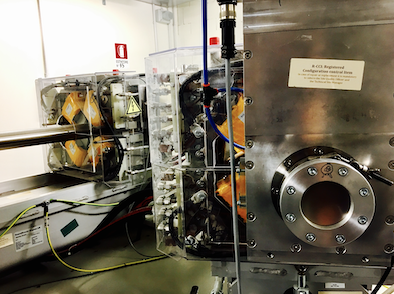Speaker
Description
Three batches (A, B, C) of thermoluminescent dosimeters TLDs-100 (LiF:Mg, Ti), provided by the team of the Radioactivity Laboratory (LaRa) of Physics Department of Federico II University of Naples, were characterized to Trento Proton Beam Line. Afterwards, the TLDs have been used to obtain the dose profile in a series of radiobiological experimental activities implemented in the context of the MoVe IT CSNV project.
TLDs are well-established devices for clinical dosimetry [1, 2]: they are close tissue equivalent (effective atomic number 8.2, compared to 7.4 for tissue), low signal fading (5%-10% per year), wide linear response range (10 mGy-10 Gy), spatial resolution of 2 mm and high sensitivity [3]. The chips have density of 2.64 g/cm3 and nominal dimensions of 3.2 × 3.2 × 0.89 mm3, resulting easy to handle and peaceable in small inserts.
To enable the TLDs as dosimeters, an adequate calibration procedure in the range and beam of interest is necessary [4]. In order to characterize the TLDs, first they were exposed at TIFPA facility delivering a dose of 2 Gy. Therefore, the intrinsic sensitivity coefficient was calculated for each TLD and the calibration factor for each batch was carried out. Each TLDs batch was calibrated in the dose range 0-20 Gy obtaining the corresponding calibration curves. The calibration curves for each batch of TLD resulted to be linear in the dose range 0-10 Gy, whereas the quadratic model performs better than the linear model above 10 Gy dose level. The calibration factors in the range 0-10 Gy resulted equal to 4.6 ± 0.2 µC/Gy, 4.9 ± 0.1 µC/Gy and 5.4 ± 0.1 µC/Gy for the batch A, B and C respectively.
Prior to each irradiation, TLDs were annealed in air at 400 °C for 1 hour, followed by a 2 hours annealing at 100 °C [5]. Several exposures of TLDs were performed, irradiating the dosimeters simultaneously to different cell lines: CHO-K1 cells, MDAMB-231 and U87. Both cells and TLDs were inserted in a biophantom designed by the biological dosimetry team on purpose. The monoenergetic proton beam of initial energy of 150 MeV, entered orthogonally to the biophantom. The planned dose ranged between 0.8-1.5 Gy in the Bragg peak. After each irradiation, the readout of TLDs was performed by a Harshaw model 3500 manual TLD reader. The TLDs have been read at 300 °C using a heating rate of 10 °C/s to optimize the TL signal-to-background ratio in the high temperature region. A continuous nitrogen flow was used to reduce chemiluminescence and spurious signals not related to the irradiation [6].
Depending on the belonging batch of the irradiated TLD, the proper calibration factor was used to obtain the dose absorbed to the cells along the proton beam in combination with the measure of the radiation-induced DNA damage, aiming to derive the value of Relative Biological Effectiveness (RBE).
The results of the experiments showed the feasibility of using TLDs-100 for dose verification in high energy proton beam.
References
1. Liuzzi, R., Consiglio P, D'Avino V, Clemente S, Oliviero C, Cella L, Pugliese M. Dose-Response of TLD-100 in the Dose Range Useful for Hypofractionated Radiotherapy. Dose Response, 2020;18(1):1559325819894081.
2. Liuzzi R, Savino F, D'Avino V, Pugliese M, Cella L. Evaluation of LiF:Mg,Ti (TLD-100) for Intraoperative Electron Radiation Therapy Quality Assurance. PLoS One, 2015;10(10):e0139287.
3. Horowitz YS, Oster L, Datz H. The thermoluminescence dose-response and other characteristics of the high-temperature TL in LiF:Mg,Ti (TLD-100). Radiat Prot Dosimetry, 2007;124(2):191-205.
4. Podgoršak EB. International Atomic Energy Agency, Radiation Dosimeters, in Radiation oncology physics: a handbook for teachers and students. International Atomic Energy Agency, Radiation Oncology Physics, IAEA, 2005, Vienna.
5. Rudén BI. Evaluation of the Clinical Use of TLD. Acta Radiol Ther Phys Biol, 1976;15:447-464.
6. Massillon-JL G, Gamboa-deBuen I, Brandan ME. Onset of supralinear response in TLD-100 exposed to 60Co gamma-rays. Phys D Appl Phys, 2006;39(2):262-268.

